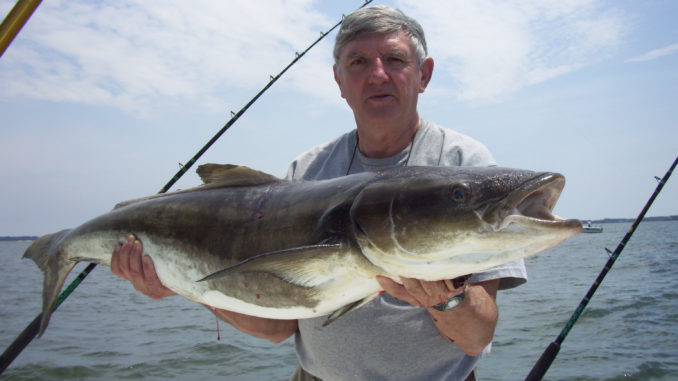
Live bait, artificials and even flies will draw strikes from a hungry cobia.
Cobia. Just the mention of the great gamefish gets many anglers excited, even more so after the winter has given way to spring, especially in the Lowcountry.
Great numbers of fish will move in and take up residence in the inshore and nearshore waters around Beaufort and Hilton Head for a glorious month or more, creating a perfect storm of the angling variety.
Mark Nutting of Loco Fly Charters in Bluffton sums up why so many anglers look forward to the cobia migration.
“We have a lot of big fish visit our inshore waters throughout the summer and fall, like jacks and tarpon, but cobia are the first big brutes to arrive, (and) it’s exciting to feel that hard pull after several months of limited opportunities for big fish,” he said.
With fish in the 30- to 50-pound range common and and some specimens pushing toward triple-digits, cobia are a hearty fish with a voracious appetite rivaled only by the intensity they show after a hookup. Anglers head to boat ramps in droves when cobia arrive, often launching before sunrise and not returning until sundown — a true testament to appeal of this gamefish and the obsession fishermen have for it.
Examining the contents of a cobia’s stomach yields a variety rivaling any Grand Strand seafood smorgasbord. Finding a live bait that a cobia won’t eat is a much-tougher task than finding one he will, but they do seem to prefer some offerings more than others. On those days when boats seem to outnumber the fish, having the preferred bait can make a big difference between success and failure. Guide Jason DuBose of Oldfield Plantation said, “Depending on the situation, I use pogeys (menhaden), threadfin and occasionally mullet.”
Many fishermen will pick up a slimy batch of wriggling eels on their way to the boat ramp. Eels are a traditional bait for cobia, and they’re one of the few big baits that can be kept alive in a bait tank for any length of time, but Lowcountry waters don’t have many eels, so fishermen who catch their own baits not only have a superior bait to offer, they save money as well.
Fishermen in search of their own bait may use Sabiki rigs around bridge pilings or search for schools of bait with a cast net in hand.
“Big, choker-size pogeys are a great bait,” Dubose said. “I look for birds diving and dimples in the water that indicate a school. Big threadfin are a good choice, too, and they are often found near sandbars.”
DuBose throws a 10- to 12-foot cast net with 5/8-inch mesh for menhaden and 3/8-inch mesh for threadfin, because he feels like the larger mesh tends to “beat up” threadfins. And he gets an early start as much because of the bait as the cobia.
“Always try to be the first boat out, because cobia definitely respond to pressure,” he said. “If the sun is peeping up at 6:45, I’m heading out by 5:45 and catching bait by first light.”
DuBose targets cobia in both inshore and nearshore waters. A favorite spot around 20 miles off Hilton Head is the Betsy Ross Reef; DuBose likes fishing it as well but keeps his options open in case the party gets too crowded, especially on the weekends.
“When the crowd moves in on the Betsy, I move to other spots like the Eagles Nest and Hilton Head Tire Reef, because really, all of the reefs will hold good numbers of cobia during the season,” he said.
Using stout gear, fishermen are able to handle big baits and hard-fighting cobia with relative ease. DuBose uses conventional rods and reels for bottom fishing and spinning gear on top. Both types of reels are loaded with 65-pound braid with 5 feet of 50-pound mono leader on the bottom and 3 feet under a cork on top. To reach the bottom quickly, and fight current, his bottom rigs also have 8 ounces of weight attached. Circle hooks in size 7/0 hook up the larger menhaden; he uses 5/0 for threadfin.
Chumming is popular and effective tactic for cobia; it’s not unusual for cobia to cruise right up in a chum slick behind a boat.
“I’m never out on a cobia charter without chum,” said DuBose, whose first choice is fresh menhaden that he cuts and/or smashes. If he doesn’t have enough fresh menhaden available, he will resort to frozen chum blocks, but he always has chum in the water.
There is no doubting the effectiveness of live bait on cobia, but fishermen have other options. Many anglers forgo bait, chum and anchors altogether and hunt for cruising cobia by sight. Nutting is one of those; he spends much of May on the Broad River and Port Royal Sound cruising at a rate not much faster than idle.
“I am always on the lookout for cobia when I am on the water, searching for that push on the surface,” he said.
Leaving the dock armed only with flies and fly rods is a technique growing in popularity. Given the proper presentation, a cobia will slam a fly in a visual exhibition that is second to none. The problem is that the right conditions for sight-fishing are not consistent. Cobia will often cruise near the surface in search of their next meal, especially on a slack tide just before or after a tide change. When this happens, they leave a visible wake much like a mullet, but amplified many times. Spotting cruising cobia from 100 or more yards is easy when the wind is low and the water glassy, but let the wind pick up a little and the game changes.
Because of this, many anglers who want to sight-fish don’t bother if the forecast is anything less than perfect — but not Nutting. When the wind blows, he adjusts his tactics to match the conditions. If the wind is blowing across the river, he focuses on the leeward side where the water has less distortion. He also plans for when it is blowing straight up or down, or a little harder.
“Many people overlook the mouths of big creeks or small rivers flowing into the Broad River and Port Royal Sound and just focus on big water, but I have seen a lot of cobia in these areas,” he said. “When the conditions change, you have to be ready to change with them.”
Nutting looks for more than just a calm surface when searching for cobia.
“Whenever I see a lot of jelly balls in an area, I slow down and search harder because it is not uncommon for a blue crab to be latched on to one, and cobia love crabs, so find a big group of jelly balls and chances are, you will find a cobia, too.”
Locating a cruising cobia can be a daunting challenge, and once found, catching one is still far from a sure thing. Presentation is important, and just because a fly is placed in a cobia’s line of sight does not guarantee a strike. After finding a cobia Nutting chooses his next steps carefully.
“Many people approach too fast, and even though a cobia will often stay up even with a boat pushing hard on it, the pressure will affect their behavior, so I am always cautious with my approach,” he said.
Any fly, lure or bait presented to a cobia will be much more effective if it’s in front of them and moving away. Cobia are accustomed to charging prey because nothing swimming that can fit in a cobia’s mouth is going to head towards it.
“It doesn’t matter if the cobia is swimming alongside of the boat or coming at the boat; the trick is to have the fly close to them but moving away at the same time,” he said. “Even if I am parallel, I want the fly to be moving across and away from the fish.”
Trying to entice a cobia to strike, fly anglers will strip their flies very fast. A fly stripped slowly often goes unnoticed, a cobia reacts to a lot of movement. Big, flashy flies will help grab a cobia’s attention as well.
A hook-up preceded by several follows and rejections is not unusual. Nutting goes in a different direction to attract a cobia’s attention; he uses smaller flies made up of materials like marabou and fin-coon that create a lot of movement.
“I use a smaller, less-flashy fly than most because I want to give cobia something different to look at, and using materials that have a lot of natural movement means I can fish it slower and stay in the zone longer, increasing the chances a cobia will eat on the first or second cast,” he said.
When a cobia takes the fly Nutting sets the hook using a “strip strike” technique — setting the hook by pulling on the fly line instead of lifting the rod.
“I set the hook on a cobia right away, and I will also give it a couple more pulls after that, because when a cobia first hits he can bite down on the hook so hard that it feels like it is set solid but in reality it isn’t,” he said.
After the hookset, the real fun begins.
DESTINATION INFORMATION
HOW TO GET THERE — The Broad River and Port Royal Sound are easily accessed from anywhere in the Beaufort/Bluffton/Hilton Head area, via I-95 and US 21 or US 278 and SC 170. Popular public ramps are off SC 170 at the Broad River and Chechessee River bridges and at the US 278 bridge from the mainland to Hilton Head Island.
WHEN TO GO — May is the peak month of the spring cobia migration. Some fish will arrive in late April, and some may stay into early June.
TACKLE — It takes fairly heavy tackle to subdue a big cobia. Guide Jason DuBose fishes a 7-foot Ugly Stik in spinning and conventional models, mated with a Penn 7500SS spinning reel of Avet LX 6.0 conventional reel, both spooled with 65-pound Power Pro braid, with a 50-pound monofilament leader. For fly-fishing tackle, guide Mark Nutting fishes a 9-foot, 12-weight Clutch rod and Nautilus reel spooled with Rio WF12F line and a 7-foot tapered leader with a 30-inch tippet of 50-pound fluorocarbon.
FISHING INFO/GUIDES — Southern Drawl Outfitters, Hilton Head Island, 843-705-6010, www.southerndrawloutfitters.com; Capt. Jason DuBose, Oldfield Plantation, Okatie, 843-304-4834, www.oldfield1732.com; Capt. Mark Nutting, Loco Fly Charters, Bluffton, 843-540-7302, www.locoflycharters.com. See also Guides and Charters in Classifieds.
ACCOMMODATIONS — Beaufort Regional Chamber of Commerce, 843-525-8500, www.beaufortsc.org; Hilton Head Island Visitors Bureau, 843-785-3673, www.hiltonheadisland.org.
MAPS — Capt. Segull’s Nautical Charts, 888-473-4855, www.captainsegullcharts.com.

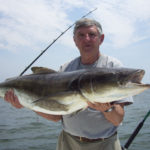
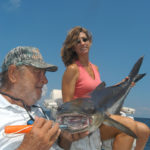
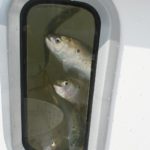
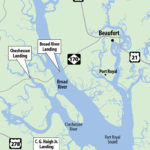



Be the first to comment